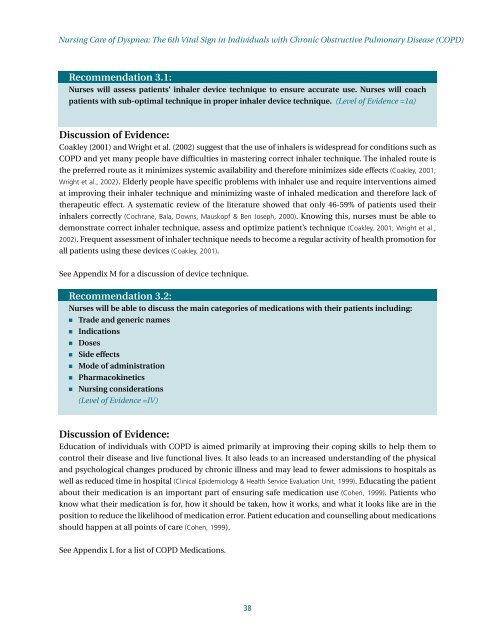Nursing Care of Dyspnea: The 6th Vital Sign in Individuals with ...
Nursing Care of Dyspnea: The 6th Vital Sign in Individuals with ...
Nursing Care of Dyspnea: The 6th Vital Sign in Individuals with ...
Create successful ePaper yourself
Turn your PDF publications into a flip-book with our unique Google optimized e-Paper software.
<strong>Nurs<strong>in</strong>g</strong> <strong>Care</strong> <strong>of</strong> <strong>Dyspnea</strong>: <strong>The</strong> <strong>6th</strong> <strong>Vital</strong> <strong>Sign</strong> <strong>in</strong> <strong>Individuals</strong> <strong>with</strong> Chronic Obstructive Pulmonary Disease (COPD)Recommendation 3.1:Nurses will assess patients’ <strong>in</strong>haler device technique to ensure accurate use. Nurses will coachpatients <strong>with</strong> sub-optimal technique <strong>in</strong> proper <strong>in</strong>haler device technique. (Level <strong>of</strong> Evidence =1a)Discussion <strong>of</strong> Evidence:Coakley (2001) and Wright et al. (2002) suggest that the use <strong>of</strong> <strong>in</strong>halers is widespread for conditions such asCOPD and yet many people have difficulties <strong>in</strong> master<strong>in</strong>g correct <strong>in</strong>haler technique. <strong>The</strong> <strong>in</strong>haled route isthe preferred route as it m<strong>in</strong>imizes systemic availability and therefore m<strong>in</strong>imizes side effects (Coakley, 2001;Wright et al., 2002). Elderly people have specific problems <strong>with</strong> <strong>in</strong>haler use and require <strong>in</strong>terventions aimedat improv<strong>in</strong>g their <strong>in</strong>haler technique and m<strong>in</strong>imiz<strong>in</strong>g waste <strong>of</strong> <strong>in</strong>haled medication and therefore lack <strong>of</strong>therapeutic effect. A systematic review <strong>of</strong> the literature showed that only 46-59% <strong>of</strong> patients used their<strong>in</strong>halers correctly (Cochrane, Bala, Downs, Mauskopf & Ben Joseph, 2000). Know<strong>in</strong>g this, nurses must be able todemonstrate correct <strong>in</strong>haler technique, assess and optimize patient’s technique (Coakley, 2001; Wright et al.,2002). Frequent assessment <strong>of</strong> <strong>in</strong>haler technique needs to become a regular activity <strong>of</strong> health promotion forall patients us<strong>in</strong>g these devices (Coakley, 2001).See Appendix M for a discussion <strong>of</strong> device technique.Recommendation 3.2:Nurses will be able to discuss the ma<strong>in</strong> categories <strong>of</strong> medications <strong>with</strong> their patients <strong>in</strong>clud<strong>in</strong>g:■■■■■■■Trade and generic namesIndicationsDosesSide effectsMode <strong>of</strong> adm<strong>in</strong>istrationPharmacok<strong>in</strong>etics<strong>Nurs<strong>in</strong>g</strong> considerations(Level <strong>of</strong> Evidence =IV)Discussion <strong>of</strong> Evidence:Education <strong>of</strong> <strong>in</strong>dividuals <strong>with</strong> COPD is aimed primarily at improv<strong>in</strong>g their cop<strong>in</strong>g skills to help them tocontrol their disease and live functional lives. It also leads to an <strong>in</strong>creased understand<strong>in</strong>g <strong>of</strong> the physicaland psychological changes produced by chronic illness and may lead to fewer admissions to hospitals aswell as reduced time <strong>in</strong> hospital (Cl<strong>in</strong>ical Epidemiology & Health Service Evaluation Unit, 1999). Educat<strong>in</strong>g the patientabout their medication is an important part <strong>of</strong> ensur<strong>in</strong>g safe medication use (Cohen, 1999). Patients whoknow what their medication is for, how it should be taken, how it works, and what it looks like are <strong>in</strong> theposition to reduce the likelihood <strong>of</strong> medication error. Patient education and counsell<strong>in</strong>g about medicationsshould happen at all po<strong>in</strong>ts <strong>of</strong> care (Cohen, 1999).See Appendix L for a list <strong>of</strong> COPD Medications.38
















